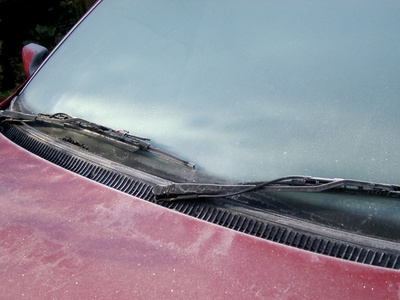
A Honda Civic, or virtually any other gasoline-powered car, can fail to start at cold temperatures due to a variety of reasons, including insufficient battery power, engine oil that is too thick and frozen coolant. In order to get the car moving as quickly and easily as possible, a jump start is usually the best option. Another option, though less reliable and more time-consuming, is to warm up your engine with the exhaust gas of another vehicle. Once the car has been started, you should check your battery and oil in order to prevent a non-start in the future.
Jump start your vehicle by connecting your battery to that of another car. With both engines off, connect one of the jumper cable's clamps onto the dead car battery's positive pole terminal and the other end of the same cable to the jumper car battery's positive terminal. Now connect the other cable's one end to the jumper car's negative terminal. Connect the other end of that same cable to a metal piece on the dead car. Now start the jumper car, and after a minute or so, start the Honda Civic. Before you attempt to start the car make sure that every accessory and all lights are turned off. You can now carefully disconnect the jumper cable and drive off.
If you do not have jumper cables but can find a hose that would fit in another vehicle's exhaust pipe, you may be able to heat up the Honda's engine bay. Attach the hose to the exhaust pipe of the working vehicle and place the other end on the ground, pointing upward into the engine bay of the Honda Civic. You will have to keep the engine of the good car running for an extended period, and even then this method has a lower probability of success than a jump start. It is, however, worth a try in the absence of jumper cables. This technique must ONLY be tried if the Civic and other vehicle are parked where there is full ventilation to prevent carbon monoxide hazards. If you're successful in starting the Civic, do not get in and drive away until you're certain the passenger cabin is completely free of exhaust fumes.
Check your oil and antifreeze. Once you have started the Civic by using one of the methods above, you or a mechanic should check your antifreeze and oil. Insufficient antifreeze can make it harder to start your vehicle, as will the use of excessively dense motor oil. You can check the level of the antifreeze yourself, but the freezing point of your antifreeze can only be checked by a mechanic with special equipment. He or she will then readjust the freezing point as needed by changing the ratio of antifreeze to water. As for oil, a slightly thinner type may help avoid a non-start in the future, but the selection of motor oil must be done strictly in accordance with your Honda's user guide. Selecting the wrong oil can result in serious damage to your engine. Therefore, consult an authorized service center or a trusted mechanic if you wish to experiment with a different type and brand than what is recommended in your car's user manual.
Use the correct start-up procedure in cold weather. Using the proper cold weather start-up procedure, recommended in your Honda's user manual, will avoid draining the battery and will make subsequent starts less troublesome. Before you attempt to start your engine, turn off all electrical accessories and lights. Push the accelerator pedal halfway while starting the engine. Do not hold the ignition key in START for more than 15 seconds. If the engine fails to start, wait a few seconds, then press the accelerator pedal fully while you crank the engine for no more than 15 seconds.